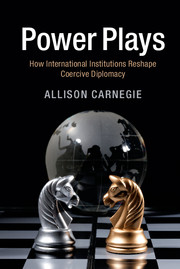Book contents
- Frontmatter
- Contents
- Figures
- Tables
- Acknowledgments
- 1 Introduction
- 2 Theoretical Framework
- 3 Bilateral Agreements and State Similarity
- 4 WTO Membership as a Commitment Strategy
- 5 Coercive Diplomacy in Comparative Perspective
- 6 Agreements and the Displacement of Coercion
- 7 Reduced Effectiveness of Coercion: Evidence from the United States
- 8 Conclusion
- Bibliography
- Index
5 - Coercive Diplomacy in Comparative Perspective
Published online by Cambridge University Press: 05 November 2015
- Frontmatter
- Contents
- Figures
- Tables
- Acknowledgments
- 1 Introduction
- 2 Theoretical Framework
- 3 Bilateral Agreements and State Similarity
- 4 WTO Membership as a Commitment Strategy
- 5 Coercive Diplomacy in Comparative Perspective
- 6 Agreements and the Displacement of Coercion
- 7 Reduced Effectiveness of Coercion: Evidence from the United States
- 8 Conclusion
- Bibliography
- Index
Summary
The use of intimidation of one kind or another in order to get others to comply with one's wishes is an everyday occurrence in human affairs.
Alexander GeorgeThe argument developed in this study starts from the premise that political hold-up problems represent a central feature of international relations. The theoretical model presented in Chapter 2 developed predictions regarding the conditions under which these hold-up problems pervade interstate interactions, generating testable implications to help account for variation in outcomes across WTO members. The statistical results of the previous chapters, both the baseline results and the tests of the mechanism at work, comport with these hypotheses. Yet doubts may remain about whether the particular mechanisms that my theory identifies drive the findings. It is therefore important to take a closer look at the case-study evidence to try to tease out the causal processes. Moreover, a case study analysis can help to support and enhance the theoretical approach taken in Chapter 2.
Because the theory suggests that the WTO's impact depends on the degree of similarity between pairs of states, in terms of both capabilities and political interests, it is logical to select states based on variation in these key independent variables. In particular, I consider three countries at a time: a state, which I refer to as a “primary” state for clarity, and two of its trading partners. Because I am interested in the impact of joint WTO membership, I require both trading partners to be WTO members at the time of the primary state's WTO accession. Out of this pool I then select one partner state that possesses capabilities and political interests that are highly dissimilar to those of the primary state, along with a second partner that is very similar to the primary state along these dimensions. I also ensure that primary states and their partners represent diverse regions and that primary states’ WTO accession dates differ.
The case studies analyzed in this chapter thus pull together the prior chapters' discussion and findings to illustrate how these dynamics manifest themselves in specific examples. In each case I show that political hold-up problems were ubiquitous prior to the primary state's WTO accession, particularly with its dissimilar partner. These problems resulted in underinvestment and low bilateral trade, which WTO membership then remedied.
- Type
- Chapter
- Information
- Power PlaysHow International Institutions Reshape Coercive Diplomacy, pp. 89 - 108Publisher: Cambridge University PressPrint publication year: 2015



